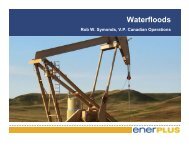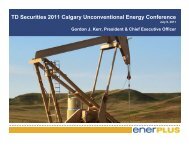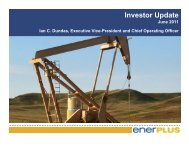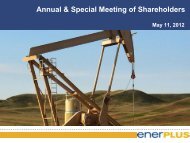68. RETAILTexasmarketingpresentationFINAL.pdf - Enerplus
68. RETAILTexasmarketingpresentationFINAL.pdf - Enerplus
68. RETAILTexasmarketingpresentationFINAL.pdf - Enerplus
Create successful ePaper yourself
Turn your PDF publications into a flip-book with our unique Google optimized e-Paper software.
Disclaimers<br />
For information regarding the primary contingencies which currently prevent the classification of our disclosed “contingent resources” associated with our Marcellus<br />
shale gas assets as reserves and the positive and negative factors relevant to the “contingent resource” estimate, see our Annual Information Form for the year<br />
ended December 31, 2009 (and corresponding Form 40-F) dated March 12, 2010, a copy of which is available on our SEDAR profile at www.sedar.com and a<br />
copy of the Form 40-F which is available on our EDGAR profile at www.sec.gov. With respect to the “contingent resource” estimate for our North Dakota Bakken<br />
properties, the primary contingencies which currently prevent the classification of our disclosed “contingent resources” associated with the properties as "reserves"<br />
consist of additional delineation drilling to establish economic productivity in the development areas and limitations to development based on adverse topography<br />
or other surface restrictions. Significant positive factors related to the estimate include; continued advancement of drilling and completion technology and early<br />
performance of producing wells that are above forecast. A significant negative factor related to the estimate is the limited performance history in the immediate<br />
area of the “contingent resource”. With respect to our Waterflood assets, the primary contingencies which currently prevent the classification of our disclosed<br />
“contingent resources” associated with the properties as "reserves" are due to the early stage of implementation to the specific patterns within the existing<br />
waterfloods and the early stage of the specific enhanced oil recovery projects to the existing waterfloods. Significant positive factors related to the estimate include<br />
established waterflood technology, the history of waterflood performance data and the estimates are based on incremental recovery from higher displacement<br />
efficiency only with no improved recovery from additional areal sweep. A significant negative factor relevant to this estimate is the geological complexity and its<br />
effect on injector producer connectivity. There are a number of inherent risks and contingencies associated with the development of our interests in these<br />
properties including commodity price fluctuations, project costs, our ability to make the necessary capital expenditures to develop the properties, reliance on our<br />
industry partners in project development, acquisitions, funding and provisions of services and those other risks and contingencies described above, and that apply<br />
generally to oil and gas operations as described above, and under "Risk Factors" in our Annual Information Form referred to above.<br />
F&D Costs<br />
F&D costs presented are calculated (i) in the case of F&D costs for proved reserves, by dividing the sum of exploration and development costs incurred in the year<br />
plus the change in estimated future development costs in the year, by the additions to proved reserves in the year, and (ii) in the case of F&D costs for proved plus<br />
probable reserves, by dividing the sum of exploration and development costs incurred in the year plus the change in estimated future development costs in the<br />
year, by the additions to proved plus probable reserves in the year. The aggregate of the exploration and development costs incurred in the most recent financial<br />
year and the change during that year in estimated future development costs generally will not reflect total finding and development costs related to its reserves<br />
additions for that year.<br />
Non-GAAP Measures<br />
In these presentations, we use the terms "payout ratio" and "adjusted payout ratio" to analyze operating performance, leverage and liquidity, and the term "F&D<br />
costs" as a measure of operating performance. We calculate "payout ratio" by dividing cash distributions to unitholders by cash flow from operating activities, both<br />
of which are measures prescribed by Canadian generally accepted accounting principles ("GAAP") and which appear on our consolidated statements of cash flow.<br />
"Adjusted payout ratio" is calculated as cash distributions to unitholders plus development capital and office expenditures, divided by cash flow from operating<br />
activities. We also use the term "netback", which is used to measure operating performance and is calculated by subtracting <strong>Enerplus</strong>’ expected royalties and<br />
operating costs from the anticipated revenues in respect of the relevant properties. <strong>Enerplus</strong> believes that, in addition to net earnings and other measures<br />
prescribed by GAAP, the terms "payout ratio", "adjusted payout ratio", "F&D costs" and "netback" are useful supplemental measures as they provide an indication<br />
of the results generated by <strong>Enerplus</strong>' principal business activities. However, these measures are not measures recognized by GAAP and do not have a<br />
standardized meaning prescribed by GAAP. Therefore, these measures, as defined by <strong>Enerplus</strong>, may not be comparable to similar measures presented by other<br />
issuers.<br />
83








